Transpilation Optimizations with SABRE
Usage estimate: under 1 minute on ibm_kingston (NOTE: This is an estimate only. Your runtime may vary.)
Background
Transpilation is a critical step in Qiskit that converts quantum circuits into forms compatible with specific quantum hardware. It involves two key stages: qubit layout (mapping logical qubits to physical qubits on the device) and gate routing (ensuring multi-qubit gates respect device connectivity by inserting SWAP gates as needed).
SABRE (SWAP-Based Bidirectional heuristic search algorithm) is a powerful optimization tool for both layout and routing. It is especially effective for large-scale circuits (100+ qubits) and devices with complex coupling maps, like the IBM Heron, where the exponential growth in possible qubit mappings demands efficient solutions.
Why use SABRE?
SABRE minimizes the number of SWAP gates and reduces circuit depth, improving circuit performance on real hardware. Its heuristic-based approach makes it ideal for advanced hardware and large, complex circuits. Recent improvements introduced in the LightSABRE algorithm further optimize SABRE’s performance, offering faster runtimes and fewer SWAP gates. These enhancements make it even more effective for large-scale circuits.
What you’ll learn
This tutorial is divided into two parts:
- Learn to use SABRE with Qiskit Patterns for advanced optimization of large circuits.
- Leverage qiskit_serverless to maximize SABRE’s potential for scalable and efficient transpilation.
You will:
- Optimize SABRE for circuits with 100+ qubits, surpassing default transpilation settings like
optimization_level=3. - Explore LightSABRE enhancements that improve runtime and reduce gate counts.
- Customize key SABRE parameters (
swap_trials,layout_trials,max_iterations,heuristic) to balance circuit quality and transpilation runtime.
Requirements
Before starting this tutorial, be sure you have the following installed:
- Qiskit SDK v1.0 or later, with visualization support (
pip install 'qiskit[visualization]') - Qiskit Runtime 0.28 or later (
pip install qiskit-ibm-runtime) - Rustworkx graph library (
pip install rustworkx) - Serverless (
pip install qiskit-ibm-catalog qiskit_serverless)
Setup
from qiskit import QuantumCircuit
from qiskit.quantum_info import SparsePauliOp
from qiskit_ibm_catalog import QiskitServerless, QiskitFunction
from qiskit_ibm_runtime import QiskitRuntimeService
from qiskit_ibm_runtime import EstimatorOptions
from qiskit_ibm_runtime import EstimatorV2 as Estimator
from qiskit.transpiler import CouplingMap
from qiskit.transpiler.passes import SabreLayout, SabreSwap
from qiskit.transpiler.preset_passmanagers import generate_preset_pass_manager
import matplotlib.pyplot as plt
import numpy as np
import timePart I. Using SABRE with Qiskit patterns
SABRE can be used in Qiskit to optimize quantum circuits by handling both the qubit layout and gate routing stages. In this section, we’ll guide you through the minimal example of using SABRE with Qiskit patterns, with the primary focus on step 2 of optimization.
To run SABRE, you need:
- A DAG (Directed Acyclic Graph) representation of your quantum circuit.
- The coupling map from the backend, which specifies how qubits are physically connected.
- The SABRE pass, which applies the algorithm to optimize the layout and routing.
For this part, we’ll focus on the SabreLayout pass. It performs both layout and routing trials, working to find the most efficient initial layout while minimizing the number of SWAP gates needed. Importantly, SabreLayout, just by itself, internally optimizes both the layout and routing by storing the solution that adds the least number of SWAP gates. Note that when using just SabreLayout, we cannot change the heuristic of SABRE, but we are able to customize the number of layout_trials.
Step 1: Map classical inputs to a quantum problem
A GHZ (Greenberger-Horne-Zeilinger) circuit is a quantum circuit that prepares an entangled state where all qubits are either in the |0...0⟩ or |1...1⟩ state. The GHZ state for qubits is mathematically represented as:
It is constructed by applying:
- A Hadamard gate to the first qubit to create superposition.
- A series of CNOT gates to entangle the remaining qubits with the first.
For this example, we intentionally construct a star-topology GHZ circuit instead of a linear-topology one. In the star topology, the first qubit acts as the "hub," and all other qubits are entangled directly with it using CNOT gates. This choice is deliberate because, while the linear topology GHZ state can theoretically be implemented in depth on a linear coupling map without any SWAP gates, SABRE would trivially find an optimal solution by mapping a 100-qubit GHZ circuit to a subgraph of the backend's heavy-hex coupling map.
The star topology GHZ circuit poses a significantly more challenging problem. Although it can still theoretically be executed in depth without SWAP gates, finding this solution requires identifying an optimal initial layout, which is much harder due to the non-linear connectivity of the circuit. This topology serves as a better test case for evaluating SABRE, as it demonstrates how configuration parameters impact layout and routing performance under more complex conditions.
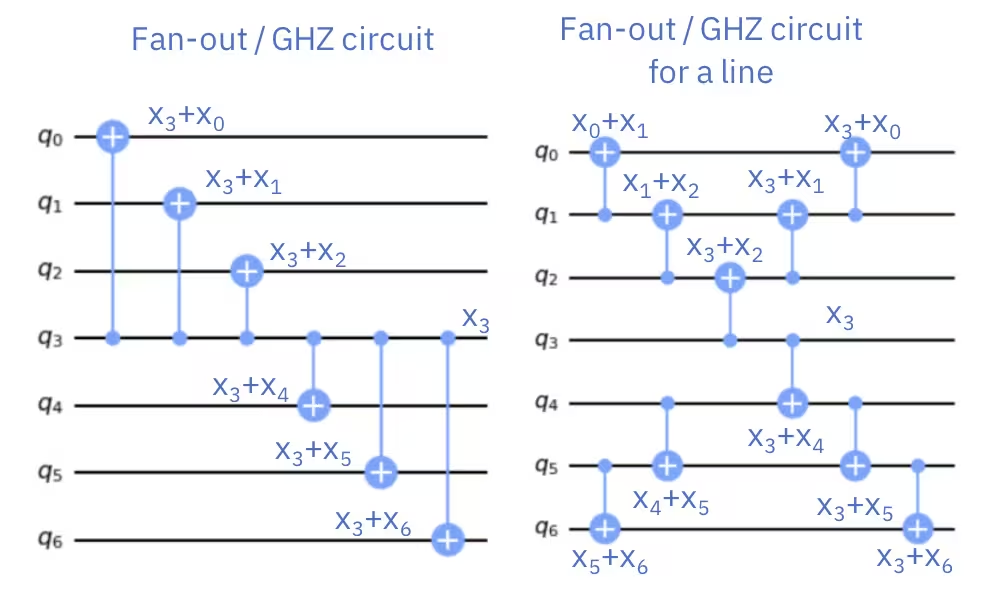
Notably:
- The HighLevelSynthesis tool can produce the optimal depth solution for the star topology GHZ circuit without introducing SWAP gates, like shown in the image above.
- Alternatively, the StarPrerouting pass can reduce the depth further by guiding SABRE's routing decisions, though it may still introduce some SWAP gates. However, StarPrerouting increases runtime and requires integration into the initial transpilation process.
For the purposes of this notebook, we exclude both HighLevelSynthesis and StarPrerouting to isolate and highlight the direct impact of SABRE configuration on runtime and circuit depth. By measuring the expectation value for each qubit pair, we analyze:
- How well SABRE reduces SWAP gates and circuit depth.
- The effect of these optimizations on the fidelity of the executed circuit, where deviations from indicate loss of entanglement.!
# set seed for reproducibility
seed = 42
num_qubits = 100
# Create GHZ circuit
qc = QuantumCircuit(num_qubits)
qc.h(0)
for i in range(1, num_qubits):
qc.cx(0, i)
qc.measure_all()Next, we will map the operators of interest to evaluate the behavior of the system. Specifically, we will use ZZ operators between qubits to examine how the entanglement degrades as the qubits become farther apart. This analysis is critical because inaccuracies in the expectation values for distant qubits can reveal the impact of noise and errors in the circuit execution. By studying these deviations, we gain insight into how well the circuit preserves entanglement under different SABRE configurations and how effectively SABRE minimizes the impact of hardware constraints.
# ZZII...II, ZIZI...II, ... , ZIII...IZ
operator_strings = [
"Z" + "I" * i + "Z" + "I" * (num_qubits - 2 - i)
for i in range(num_qubits - 1)
]
print(operator_strings)
print(len(operator_strings))
operators = [SparsePauliOp(operator) for operator in operator_strings]Output:
['ZZIIIIIIIIIIIIIIIIIIIIIIIIIIIIIIIIIIIIIIIIIIIIIIIIIIIIIIIIIIIIIIIIIIIIIIIIIIIIIIIIIIIIIIIIIIIIIIIIII', 'ZIZIIIIIIIIIIIIIIIIIIIIIIIIIIIIIIIIIIIIIIIIIIIIIIIIIIIIIIIIIIIIIIIIIIIIIIIIIIIIIIIIIIIIIIIIIIIIIIIII', 'ZIIZIIIIIIIIIIIIIIIIIIIIIIIIIIIIIIIIIIIIIIIIIIIIIIIIIIIIIIIIIIIIIIIIIIIIIIIIIIIIIIIIIIIIIIIIIIIIIIII', 'ZIIIZIIIIIIIIIIIIIIIIIIIIIIIIIIIIIIIIIIIIIIIIIIIIIIIIIIIIIIIIIIIIIIIIIIIIIIIIIIIIIIIIIIIIIIIIIIIIIII', 'ZIIIIZIIIIIIIIIIIIIIIIIIIIIIIIIIIIIIIIIIIIIIIIIIIIIIIIIIIIIIIIIIIIIIIIIIIIIIIIIIIIIIIIIIIIIIIIIIIIII', 'ZIIIIIZIIIIIIIIIIIIIIIIIIIIIIIIIIIIIIIIIIIIIIIIIIIIIIIIIIIIIIIIIIIIIIIIIIIIIIIIIIIIIIIIIIIIIIIIIIIII', 'ZIIIIIIZIIIIIIIIIIIIIIIIIIIIIIIIIIIIIIIIIIIIIIIIIIIIIIIIIIIIIIIIIIIIIIIIIIIIIIIIIIIIIIIIIIIIIIIIIIII', 'ZIIIIIIIZIIIIIIIIIIIIIIIIIIIIIIIIIIIIIIIIIIIIIIIIIIIIIIIIIIIIIIIIIIIIIIIIIIIIIIIIIIIIIIIIIIIIIIIIIII', 'ZIIIIIIIIZIIIIIIIIIIIIIIIIIIIIIIIIIIIIIIIIIIIIIIIIIIIIIIIIIIIIIIIIIIIIIIIIIIIIIIIIIIIIIIIIIIIIIIIIII', 'ZIIIIIIIIIZIIIIIIIIIIIIIIIIIIIIIIIIIIIIIIIIIIIIIIIIIIIIIIIIIIIIIIIIIIIIIIIIIIIIIIIIIIIIIIIIIIIIIIIII', 'ZIIIIIIIIIIZIIIIIIIIIIIIIIIIIIIIIIIIIIIIIIIIIIIIIIIIIIIIIIIIIIIIIIIIIIIIIIIIIIIIIIIIIIIIIIIIIIIIIIII', 'ZIIIIIIIIIIIZIIIIIIIIIIIIIIIIIIIIIIIIIIIIIIIIIIIIIIIIIIIIIIIIIIIIIIIIIIIIIIIIIIIIIIIIIIIIIIIIIIIIIII', 'ZIIIIIIIIIIIIZIIIIIIIIIIIIIIIIIIIIIIIIIIIIIIIIIIIIIIIIIIIIIIIIIIIIIIIIIIIIIIIIIIIIIIIIIIIIIIIIIIIIII', 'ZIIIIIIIIIIIIIZIIIIIIIIIIIIIIIIIIIIIIIIIIIIIIIIIIIIIIIIIIIIIIIIIIIIIIIIIIIIIIIIIIIIIIIIIIIIIIIIIIIII', 'ZIIIIIIIIIIIIIIZIIIIIIIIIIIIIIIIIIIIIIIIIIIIIIIIIIIIIIIIIIIIIIIIIIIIIIIIIIIIIIIIIIIIIIIIIIIIIIIIIIII', 'ZIIIIIIIIIIIIIIIZIIIIIIIIIIIIIIIIIIIIIIIIIIIIIIIIIIIIIIIIIIIIIIIIIIIIIIIIIIIIIIIIIIIIIIIIIIIIIIIIIII', 'ZIIIIIIIIIIIIIIIIZIIIIIIIIIIIIIIIIIIIIIIIIIIIIIIIIIIIIIIIIIIIIIIIIIIIIIIIIIIIIIIIIIIIIIIIIIIIIIIIIII', 'ZIIIIIIIIIIIIIIIIIZIIIIIIIIIIIIIIIIIIIIIIIIIIIIIIIIIIIIIIIIIIIIIIIIIIIIIIIIIIIIIIIIIIIIIIIIIIIIIIIII', 'ZIIIIIIIIIIIIIIIIIIZIIIIIIIIIIIIIIIIIIIIIIIIIIIIIIIIIIIIIIIIIIIIIIIIIIIIIIIIIIIIIIIIIIIIIIIIIIIIIIII', 'ZIIIIIIIIIIIIIIIIIIIZIIIIIIIIIIIIIIIIIIIIIIIIIIIIIIIIIIIIIIIIIIIIIIIIIIIIIIIIIIIIIIIIIIIIIIIIIIIIIII', 'ZIIIIIIIIIIIIIIIIIIIIZIIIIIIIIIIIIIIIIIIIIIIIIIIIIIIIIIIIIIIIIIIIIIIIIIIIIIIIIIIIIIIIIIIIIIIIIIIIIII', 'ZIIIIIIIIIIIIIIIIIIIIIZIIIIIIIIIIIIIIIIIIIIIIIIIIIIIIIIIIIIIIIIIIIIIIIIIIIIIIIIIIIIIIIIIIIIIIIIIIIII', 'ZIIIIIIIIIIIIIIIIIIIIIIZIIIIIIIIIIIIIIIIIIIIIIIIIIIIIIIIIIIIIIIIIIIIIIIIIIIIIIIIIIIIIIIIIIIIIIIIIIII', 'ZIIIIIIIIIIIIIIIIIIIIIIIZIIIIIIIIIIIIIIIIIIIIIIIIIIIIIIIIIIIIIIIIIIIIIIIIIIIIIIIIIIIIIIIIIIIIIIIIIII', 'ZIIIIIIIIIIIIIIIIIIIIIIIIZIIIIIIIIIIIIIIIIIIIIIIIIIIIIIIIIIIIIIIIIIIIIIIIIIIIIIIIIIIIIIIIIIIIIIIIIII', 'ZIIIIIIIIIIIIIIIIIIIIIIIIIZIIIIIIIIIIIIIIIIIIIIIIIIIIIIIIIIIIIIIIIIIIIIIIIIIIIIIIIIIIIIIIIIIIIIIIIII', 'ZIIIIIIIIIIIIIIIIIIIIIIIIIIZIIIIIIIIIIIIIIIIIIIIIIIIIIIIIIIIIIIIIIIIIIIIIIIIIIIIIIIIIIIIIIIIIIIIIIII', 'ZIIIIIIIIIIIIIIIIIIIIIIIIIIIZIIIIIIIIIIIIIIIIIIIIIIIIIIIIIIIIIIIIIIIIIIIIIIIIIIIIIIIIIIIIIIIIIIIIIII', 'ZIIIIIIIIIIIIIIIIIIIIIIIIIIIIZIIIIIIIIIIIIIIIIIIIIIIIIIIIIIIIIIIIIIIIIIIIIIIIIIIIIIIIIIIIIIIIIIIIIII', 'ZIIIIIIIIIIIIIIIIIIIIIIIIIIIIIZIIIIIIIIIIIIIIIIIIIIIIIIIIIIIIIIIIIIIIIIIIIIIIIIIIIIIIIIIIIIIIIIIIIII', 'ZIIIIIIIIIIIIIIIIIIIIIIIIIIIIIIZIIIIIIIIIIIIIIIIIIIIIIIIIIIIIIIIIIIIIIIIIIIIIIIIIIIIIIIIIIIIIIIIIIII', 'ZIIIIIIIIIIIIIIIIIIIIIIIIIIIIIIIZIIIIIIIIIIIIIIIIIIIIIIIIIIIIIIIIIIIIIIIIIIIIIIIIIIIIIIIIIIIIIIIIIII', 'ZIIIIIIIIIIIIIIIIIIIIIIIIIIIIIIIIZIIIIIIIIIIIIIIIIIIIIIIIIIIIIIIIIIIIIIIIIIIIIIIIIIIIIIIIIIIIIIIIIII', 'ZIIIIIIIIIIIIIIIIIIIIIIIIIIIIIIIIIZIIIIIIIIIIIIIIIIIIIIIIIIIIIIIIIIIIIIIIIIIIIIIIIIIIIIIIIIIIIIIIIII', 'ZIIIIIIIIIIIIIIIIIIIIIIIIIIIIIIIIIIZIIIIIIIIIIIIIIIIIIIIIIIIIIIIIIIIIIIIIIIIIIIIIIIIIIIIIIIIIIIIIIII', 'ZIIIIIIIIIIIIIIIIIIIIIIIIIIIIIIIIIIIZIIIIIIIIIIIIIIIIIIIIIIIIIIIIIIIIIIIIIIIIIIIIIIIIIIIIIIIIIIIIIII', 'ZIIIIIIIIIIIIIIIIIIIIIIIIIIIIIIIIIIIIZIIIIIIIIIIIIIIIIIIIIIIIIIIIIIIIIIIIIIIIIIIIIIIIIIIIIIIIIIIIIII', 'ZIIIIIIIIIIIIIIIIIIIIIIIIIIIIIIIIIIIIIZIIIIIIIIIIIIIIIIIIIIIIIIIIIIIIIIIIIIIIIIIIIIIIIIIIIIIIIIIIIII', 'ZIIIIIIIIIIIIIIIIIIIIIIIIIIIIIIIIIIIIIIZIIIIIIIIIIIIIIIIIIIIIIIIIIIIIIIIIIIIIIIIIIIIIIIIIIIIIIIIIIII', 'ZIIIIIIIIIIIIIIIIIIIIIIIIIIIIIIIIIIIIIIIZIIIIIIIIIIIIIIIIIIIIIIIIIIIIIIIIIIIIIIIIIIIIIIIIIIIIIIIIIII', 'ZIIIIIIIIIIIIIIIIIIIIIIIIIIIIIIIIIIIIIIIIZIIIIIIIIIIIIIIIIIIIIIIIIIIIIIIIIIIIIIIIIIIIIIIIIIIIIIIIIII', 'ZIIIIIIIIIIIIIIIIIIIIIIIIIIIIIIIIIIIIIIIIIZIIIIIIIIIIIIIIIIIIIIIIIIIIIIIIIIIIIIIIIIIIIIIIIIIIIIIIIII', 'ZIIIIIIIIIIIIIIIIIIIIIIIIIIIIIIIIIIIIIIIIIIZIIIIIIIIIIIIIIIIIIIIIIIIIIIIIIIIIIIIIIIIIIIIIIIIIIIIIIII', 'ZIIIIIIIIIIIIIIIIIIIIIIIIIIIIIIIIIIIIIIIIIIIZIIIIIIIIIIIIIIIIIIIIIIIIIIIIIIIIIIIIIIIIIIIIIIIIIIIIIII', 'ZIIIIIIIIIIIIIIIIIIIIIIIIIIIIIIIIIIIIIIIIIIIIZIIIIIIIIIIIIIIIIIIIIIIIIIIIIIIIIIIIIIIIIIIIIIIIIIIIIII', 'ZIIIIIIIIIIIIIIIIIIIIIIIIIIIIIIIIIIIIIIIIIIIIIZIIIIIIIIIIIIIIIIIIIIIIIIIIIIIIIIIIIIIIIIIIIIIIIIIIIII', 'ZIIIIIIIIIIIIIIIIIIIIIIIIIIIIIIIIIIIIIIIIIIIIIIZIIIIIIIIIIIIIIIIIIIIIIIIIIIIIIIIIIIIIIIIIIIIIIIIIIII', 'ZIIIIIIIIIIIIIIIIIIIIIIIIIIIIIIIIIIIIIIIIIIIIIIIZIIIIIIIIIIIIIIIIIIIIIIIIIIIIIIIIIIIIIIIIIIIIIIIIIII', 'ZIIIIIIIIIIIIIIIIIIIIIIIIIIIIIIIIIIIIIIIIIIIIIIIIZIIIIIIIIIIIIIIIIIIIIIIIIIIIIIIIIIIIIIIIIIIIIIIIIII', 'ZIIIIIIIIIIIIIIIIIIIIIIIIIIIIIIIIIIIIIIIIIIIIIIIIIZIIIIIIIIIIIIIIIIIIIIIIIIIIIIIIIIIIIIIIIIIIIIIIIII', 'ZIIIIIIIIIIIIIIIIIIIIIIIIIIIIIIIIIIIIIIIIIIIIIIIIIIZIIIIIIIIIIIIIIIIIIIIIIIIIIIIIIIIIIIIIIIIIIIIIIII', 'ZIIIIIIIIIIIIIIIIIIIIIIIIIIIIIIIIIIIIIIIIIIIIIIIIIIIZIIIIIIIIIIIIIIIIIIIIIIIIIIIIIIIIIIIIIIIIIIIIIII', 'ZIIIIIIIIIIIIIIIIIIIIIIIIIIIIIIIIIIIIIIIIIIIIIIIIIIIIZIIIIIIIIIIIIIIIIIIIIIIIIIIIIIIIIIIIIIIIIIIIIII', 'ZIIIIIIIIIIIIIIIIIIIIIIIIIIIIIIIIIIIIIIIIIIIIIIIIIIIIIZIIIIIIIIIIIIIIIIIIIIIIIIIIIIIIIIIIIIIIIIIIIII', 'ZIIIIIIIIIIIIIIIIIIIIIIIIIIIIIIIIIIIIIIIIIIIIIIIIIIIIIIZIIIIIIIIIIIIIIIIIIIIIIIIIIIIIIIIIIIIIIIIIIII', 'ZIIIIIIIIIIIIIIIIIIIIIIIIIIIIIIIIIIIIIIIIIIIIIIIIIIIIIIIZIIIIIIIIIIIIIIIIIIIIIIIIIIIIIIIIIIIIIIIIIII', 'ZIIIIIIIIIIIIIIIIIIIIIIIIIIIIIIIIIIIIIIIIIIIIIIIIIIIIIIIIZIIIIIIIIIIIIIIIIIIIIIIIIIIIIIIIIIIIIIIIIII', 'ZIIIIIIIIIIIIIIIIIIIIIIIIIIIIIIIIIIIIIIIIIIIIIIIIIIIIIIIIIZIIIIIIIIIIIIIIIIIIIIIIIIIIIIIIIIIIIIIIIII', 'ZIIIIIIIIIIIIIIIIIIIIIIIIIIIIIIIIIIIIIIIIIIIIIIIIIIIIIIIIIIZIIIIIIIIIIIIIIIIIIIIIIIIIIIIIIIIIIIIIIII', 'ZIIIIIIIIIIIIIIIIIIIIIIIIIIIIIIIIIIIIIIIIIIIIIIIIIIIIIIIIIIIZIIIIIIIIIIIIIIIIIIIIIIIIIIIIIIIIIIIIIII', 'ZIIIIIIIIIIIIIIIIIIIIIIIIIIIIIIIIIIIIIIIIIIIIIIIIIIIIIIIIIIIIZIIIIIIIIIIIIIIIIIIIIIIIIIIIIIIIIIIIIII', 'ZIIIIIIIIIIIIIIIIIIIIIIIIIIIIIIIIIIIIIIIIIIIIIIIIIIIIIIIIIIIIIZIIIIIIIIIIIIIIIIIIIIIIIIIIIIIIIIIIIII', 'ZIIIIIIIIIIIIIIIIIIIIIIIIIIIIIIIIIIIIIIIIIIIIIIIIIIIIIIIIIIIIIIZIIIIIIIIIIIIIIIIIIIIIIIIIIIIIIIIIIII', 'ZIIIIIIIIIIIIIIIIIIIIIIIIIIIIIIIIIIIIIIIIIIIIIIIIIIIIIIIIIIIIIIIZIIIIIIIIIIIIIIIIIIIIIIIIIIIIIIIIIII', 'ZIIIIIIIIIIIIIIIIIIIIIIIIIIIIIIIIIIIIIIIIIIIIIIIIIIIIIIIIIIIIIIIIZIIIIIIIIIIIIIIIIIIIIIIIIIIIIIIIIII', 'ZIIIIIIIIIIIIIIIIIIIIIIIIIIIIIIIIIIIIIIIIIIIIIIIIIIIIIIIIIIIIIIIIIZIIIIIIIIIIIIIIIIIIIIIIIIIIIIIIIII', 'ZIIIIIIIIIIIIIIIIIIIIIIIIIIIIIIIIIIIIIIIIIIIIIIIIIIIIIIIIIIIIIIIIIIZIIIIIIIIIIIIIIIIIIIIIIIIIIIIIIII', 'ZIIIIIIIIIIIIIIIIIIIIIIIIIIIIIIIIIIIIIIIIIIIIIIIIIIIIIIIIIIIIIIIIIIIZIIIIIIIIIIIIIIIIIIIIIIIIIIIIIII', 'ZIIIIIIIIIIIIIIIIIIIIIIIIIIIIIIIIIIIIIIIIIIIIIIIIIIIIIIIIIIIIIIIIIIIIZIIIIIIIIIIIIIIIIIIIIIIIIIIIIII', 'ZIIIIIIIIIIIIIIIIIIIIIIIIIIIIIIIIIIIIIIIIIIIIIIIIIIIIIIIIIIIIIIIIIIIIIZIIIIIIIIIIIIIIIIIIIIIIIIIIIII', 'ZIIIIIIIIIIIIIIIIIIIIIIIIIIIIIIIIIIIIIIIIIIIIIIIIIIIIIIIIIIIIIIIIIIIIIIZIIIIIIIIIIIIIIIIIIIIIIIIIIII', 'ZIIIIIIIIIIIIIIIIIIIIIIIIIIIIIIIIIIIIIIIIIIIIIIIIIIIIIIIIIIIIIIIIIIIIIIIZIIIIIIIIIIIIIIIIIIIIIIIIIII', 'ZIIIIIIIIIIIIIIIIIIIIIIIIIIIIIIIIIIIIIIIIIIIIIIIIIIIIIIIIIIIIIIIIIIIIIIIIZIIIIIIIIIIIIIIIIIIIIIIIIII', 'ZIIIIIIIIIIIIIIIIIIIIIIIIIIIIIIIIIIIIIIIIIIIIIIIIIIIIIIIIIIIIIIIIIIIIIIIIIZIIIIIIIIIIIIIIIIIIIIIIIII', 'ZIIIIIIIIIIIIIIIIIIIIIIIIIIIIIIIIIIIIIIIIIIIIIIIIIIIIIIIIIIIIIIIIIIIIIIIIIIZIIIIIIIIIIIIIIIIIIIIIIII', 'ZIIIIIIIIIIIIIIIIIIIIIIIIIIIIIIIIIIIIIIIIIIIIIIIIIIIIIIIIIIIIIIIIIIIIIIIIIIIZIIIIIIIIIIIIIIIIIIIIIII', 'ZIIIIIIIIIIIIIIIIIIIIIIIIIIIIIIIIIIIIIIIIIIIIIIIIIIIIIIIIIIIIIIIIIIIIIIIIIIIIZIIIIIIIIIIIIIIIIIIIIII', 'ZIIIIIIIIIIIIIIIIIIIIIIIIIIIIIIIIIIIIIIIIIIIIIIIIIIIIIIIIIIIIIIIIIIIIIIIIIIIIIZIIIIIIIIIIIIIIIIIIIII', 'ZIIIIIIIIIIIIIIIIIIIIIIIIIIIIIIIIIIIIIIIIIIIIIIIIIIIIIIIIIIIIIIIIIIIIIIIIIIIIIIZIIIIIIIIIIIIIIIIIIII', 'ZIIIIIIIIIIIIIIIIIIIIIIIIIIIIIIIIIIIIIIIIIIIIIIIIIIIIIIIIIIIIIIIIIIIIIIIIIIIIIIIZIIIIIIIIIIIIIIIIIII', 'ZIIIIIIIIIIIIIIIIIIIIIIIIIIIIIIIIIIIIIIIIIIIIIIIIIIIIIIIIIIIIIIIIIIIIIIIIIIIIIIIIZIIIIIIIIIIIIIIIIII', 'ZIIIIIIIIIIIIIIIIIIIIIIIIIIIIIIIIIIIIIIIIIIIIIIIIIIIIIIIIIIIIIIIIIIIIIIIIIIIIIIIIIZIIIIIIIIIIIIIIIII', 'ZIIIIIIIIIIIIIIIIIIIIIIIIIIIIIIIIIIIIIIIIIIIIIIIIIIIIIIIIIIIIIIIIIIIIIIIIIIIIIIIIIIZIIIIIIIIIIIIIIII', 'ZIIIIIIIIIIIIIIIIIIIIIIIIIIIIIIIIIIIIIIIIIIIIIIIIIIIIIIIIIIIIIIIIIIIIIIIIIIIIIIIIIIIZIIIIIIIIIIIIIII', 'ZIIIIIIIIIIIIIIIIIIIIIIIIIIIIIIIIIIIIIIIIIIIIIIIIIIIIIIIIIIIIIIIIIIIIIIIIIIIIIIIIIIIIZIIIIIIIIIIIIII', 'ZIIIIIIIIIIIIIIIIIIIIIIIIIIIIIIIIIIIIIIIIIIIIIIIIIIIIIIIIIIIIIIIIIIIIIIIIIIIIIIIIIIIIIZIIIIIIIIIIIII', 'ZIIIIIIIIIIIIIIIIIIIIIIIIIIIIIIIIIIIIIIIIIIIIIIIIIIIIIIIIIIIIIIIIIIIIIIIIIIIIIIIIIIIIIIZIIIIIIIIIIII', 'ZIIIIIIIIIIIIIIIIIIIIIIIIIIIIIIIIIIIIIIIIIIIIIIIIIIIIIIIIIIIIIIIIIIIIIIIIIIIIIIIIIIIIIIIZIIIIIIIIIII', 'ZIIIIIIIIIIIIIIIIIIIIIIIIIIIIIIIIIIIIIIIIIIIIIIIIIIIIIIIIIIIIIIIIIIIIIIIIIIIIIIIIIIIIIIIIZIIIIIIIIII', 'ZIIIIIIIIIIIIIIIIIIIIIIIIIIIIIIIIIIIIIIIIIIIIIIIIIIIIIIIIIIIIIIIIIIIIIIIIIIIIIIIIIIIIIIIIIZIIIIIIIII', 'ZIIIIIIIIIIIIIIIIIIIIIIIIIIIIIIIIIIIIIIIIIIIIIIIIIIIIIIIIIIIIIIIIIIIIIIIIIIIIIIIIIIIIIIIIIIZIIIIIIII', 'ZIIIIIIIIIIIIIIIIIIIIIIIIIIIIIIIIIIIIIIIIIIIIIIIIIIIIIIIIIIIIIIIIIIIIIIIIIIIIIIIIIIIIIIIIIIIZIIIIIII', 'ZIIIIIIIIIIIIIIIIIIIIIIIIIIIIIIIIIIIIIIIIIIIIIIIIIIIIIIIIIIIIIIIIIIIIIIIIIIIIIIIIIIIIIIIIIIIIZIIIIII', 'ZIIIIIIIIIIIIIIIIIIIIIIIIIIIIIIIIIIIIIIIIIIIIIIIIIIIIIIIIIIIIIIIIIIIIIIIIIIIIIIIIIIIIIIIIIIIIIZIIIII', 'ZIIIIIIIIIIIIIIIIIIIIIIIIIIIIIIIIIIIIIIIIIIIIIIIIIIIIIIIIIIIIIIIIIIIIIIIIIIIIIIIIIIIIIIIIIIIIIIZIIII', 'ZIIIIIIIIIIIIIIIIIIIIIIIIIIIIIIIIIIIIIIIIIIIIIIIIIIIIIIIIIIIIIIIIIIIIIIIIIIIIIIIIIIIIIIIIIIIIIIIZIII', 'ZIIIIIIIIIIIIIIIIIIIIIIIIIIIIIIIIIIIIIIIIIIIIIIIIIIIIIIIIIIIIIIIIIIIIIIIIIIIIIIIIIIIIIIIIIIIIIIIIZII', 'ZIIIIIIIIIIIIIIIIIIIIIIIIIIIIIIIIIIIIIIIIIIIIIIIIIIIIIIIIIIIIIIIIIIIIIIIIIIIIIIIIIIIIIIIIIIIIIIIIIZI', 'ZIIIIIIIIIIIIIIIIIIIIIIIIIIIIIIIIIIIIIIIIIIIIIIIIIIIIIIIIIIIIIIIIIIIIIIIIIIIIIIIIIIIIIIIIIIIIIIIIIIZ']
99
Step 2: Optimize problem for quantum hardware execution
In this step, we focus on optimizing the circuit layout for execution on a specific quantum hardware device with 127 qubits. This is the main focus of the notebook, as we perform SABRE optimizations and transpilation to achieve the best circuit performance. Using the SabreLayout pass, we determine an initial qubit mapping that minimizes the need for SWAP gates during routing. By passing the coupling_map of the target backend, SabreLayout adapts the layout to the device's connectivity constraints.
We will use generate_preset_pass_manager with optimization_level=3 for the transpilation process and customize the SabreLayout pass with different configurations. The goal is to find a setup that produces a transpiled circuit with the lowest size and/or depth, demonstrating the impact of SABRE optimizations.
Why Are Circuit Size and Depth Important?
- Lower size (gate count): Reduces the number of operations, minimizing opportunities for errors to accumulate.
- Lower depth: Shortens the overall execution time, which is critical for avoiding decoherence and maintaining quantum state fidelity.
By optimizing these metrics, we improve the circuit’s reliability and execution accuracy on noisy quantum hardware.
Select the backend.
service = QiskitRuntimeService()
backend = service.least_busy(
operational=True, simulator=False, min_num_qubits=127
)
print(f"Using backend: {backend}")Output:
Using backend: <IBMBackend('ibm_kingston')>
To evaluate the impact of different configurations on circuit optimization, we will create three pass managers, each with unique settings for the SabreLayout pass. These configurations enable us to analyze the trade-off between circuit quality and transpilation time.
Key parameters
max_iterations: The number of forward-backward routing iterations to refine the layout and reduce routing costs.layout_trials: The number of random initial layouts tested, selecting the one that minimizes SWAP gates.swap_trials: The number of routing trials for each layout, refining gate placement for better routing.
Increasing layout_trials and swap_trials enables more thorough optimization but increases transpilation time.
Configurations in this notebook
-
pm_1: Default settings withoptimization_level=3.max_iterations=4layout_trials=20swap_trials=20
-
pm_2: Increases the number of trials for better exploration.max_iterations=4layout_trials=200swap_trials=200
-
pm_3: Extendspm_2by increasing the number of iterations for further refinement.max_iterations=8layout_trials=200swap_trials=200
By comparing the results of these configurations, we aim to determine which achieves the best balance between circuit quality (e.g., size and depth) and computational cost.
# Get the coupling map from the backend
cmap = CouplingMap(backend().configuration().coupling_map)
# Create the SabreLayout passes for the custom configurations
sl_2 = SabreLayout(
coupling_map=cmap,
seed=seed,
max_iterations=4,
layout_trials=200,
swap_trials=200,
)
sl_3 = SabreLayout(
coupling_map=cmap,
seed=seed,
max_iterations=8,
layout_trials=200,
swap_trials=200,
)
# Create the pass managers, need to first create then configure the SabreLayout passes
pm_1 = generate_preset_pass_manager(
optimization_level=3, backend=backend, seed_transpiler=seed
)
pm_2 = generate_preset_pass_manager(
optimization_level=3, backend=backend, seed_transpiler=seed
)
pm_3 = generate_preset_pass_manager(
optimization_level=3, backend=backend, seed_transpiler=seed
)Now we can configure the SabreLayout pass in the custom pass managers. To do this we know that for the default generate_preset_pass_manager on optimization_level=3, the SabreLayout pass is at index 2, as SabreLayout occurs after SetLayout and VF2Laout passes. We can access this pass and modify its parameters.
pm_2.layout.replace(index=2, passes=sl_2)
pm_3.layout.replace(index=2, passes=sl_3)With each pass manager configured, we will now execute the transpilation process for each. To compare results, we will track key metrics, including the transpilation time, the depth of the circuit (measured as the two-qubit gate depth), and the total number of gates in the transpiled circuits
# Transpile the circuit with each pass manager and measure the time
t0 = time.time()
tqc_1 = pm_1.run(qc)
t1 = time.time() - t0
t0 = time.time()
tqc_2 = pm_2.run(qc)
t2 = time.time() - t0
t0 = time.time()
tqc_3 = pm_3.run(qc)
t3 = time.time() - t0
# Obtain the depths and the total number of gates (circuit size)
depth_1 = tqc_1.depth(lambda x: x.operation.num_qubits == 2)
depth_2 = tqc_2.depth(lambda x: x.operation.num_qubits == 2)
depth_3 = tqc_3.depth(lambda x: x.operation.num_qubits == 2)
size_1 = tqc_1.size()
size_2 = tqc_2.size()
size_3 = tqc_3.size()
# Transform the observables to match the backend's ISA
operators_list_1 = [op.apply_layout(tqc_1.layout) for op in operators]
operators_list_2 = [op.apply_layout(tqc_2.layout) for op in operators]
operators_list_3 = [op.apply_layout(tqc_3.layout) for op in operators]
# Compute improvements compared to pass manager 1 (default)
depth_improvement_2 = ((depth_1 - depth_2) / depth_1) * 100
depth_improvement_3 = ((depth_1 - depth_3) / depth_1) * 100
size_improvement_2 = ((size_1 - size_2) / size_1) * 100
size_improvement_3 = ((size_1 - size_3) / size_1) * 100
time_increase_2 = ((t2 - t1) / t1) * 100
time_increase_3 = ((t3 - t1) / t1) * 100
print(
f"Pass manager 1 (4,20,20) : Depth {depth_1}, Size {size_1}, Time {t1:.4f} s"
)
print(
f"Pass manager 2 (4,200,200): Depth {depth_2}, Size {size_2}, Time {t2:.4f} s"
)
print(f" - Depth improvement: {depth_improvement_2:.2f}%")
print(f" - Size improvement: {size_improvement_2:.2f}%")
print(f" - Time increase: {time_increase_2:.2f}%")
print(
f"Pass manager 3 (8,200,200): Depth {depth_3}, Size {size_3}, Time {t3:.4f} s"
)
print(f" - Depth improvement: {depth_improvement_3:.2f}%")
print(f" - Size improvement: {size_improvement_3:.2f}%")
print(f" - Time increase: {time_increase_3:.2f}%")Output:
Pass manager 1 (4,20,20) : Depth 403, Size 1824, Time 0.2273 s
Pass manager 2 (4,200,200): Depth 380, Size 1675, Time 4.1786 s
- Depth improvement: 5.71%
- Size improvement: 8.17%
- Time increase: 1738.12%
Pass manager 3 (8,200,200): Depth 389, Size 1662, Time 3.9678 s
- Depth improvement: 3.47%
- Size improvement: 8.88%
- Time increase: 1645.39%
The results demonstrate that increasing the number of trials (layout_trials and swap_trials) can significantly improve circuit quality by reducing both depth and size. However, this improvement often comes at the cost of increased runtime due to the additional computation required to explore more potential layouts and routing paths.
Increasing the max_iterations can further enhance optimization by refining the layout through more forward-backward routing cycles. In this case, increasing max_iterations resulted in the most significant reduction in circuit depth and size, even reducing runtime compared to pm_2, likely by streamlining subsequent optimization stages. It’s important to note, however, that the effectiveness of increasing max_iterations can vary significantly depending on the circuit. While more iterations may yield better layout and routing choices, they provide no guarantees and depend heavily on the circuit’s structure and the complexity of the connectivity constraints
# Plot the results of the metrics
times = [t1, t2, t3]
depths = [depth_1, depth_2, depth_3]
sizes = [size_1, size_2, size_3]
pm_names = [
"pm_1 (4 iter, 20 trials)",
"pm_2 (4 iter, 200 trials)",
"pm_3 (8 iter, 200 trials)",
]
colors = plt.cm.viridis(np.linspace(0.2, 0.8, len(pm_names)))
# Create a figure with three subplots
fig, axs = plt.subplots(3, 1, figsize=(6, 9), sharex=True)
axs[0].bar(pm_names, times, color=colors)
axs[0].set_ylabel("Time (s)", fontsize=12)
axs[0].set_title("Transpilation Time", fontsize=14)
axs[0].grid(axis="y", linestyle="--", alpha=0.7)
axs[1].bar(pm_names, depths, color=colors)
axs[1].set_ylabel("Depth", fontsize=12)
axs[1].set_title("Circuit Depth", fontsize=14)
axs[1].grid(axis="y", linestyle="--", alpha=0.7)
axs[2].bar(pm_names, sizes, color=colors)
axs[2].set_ylabel("Size", fontsize=12)
axs[2].set_title("Circuit Size", fontsize=14)
axs[2].set_xticks(range(len(pm_names)))
axs[2].set_xticklabels(pm_names, fontsize=10, rotation=15)
axs[2].grid(axis="y", linestyle="--", alpha=0.7)
# Add some spacing between subplots
plt.tight_layout()
plt.show()Output:
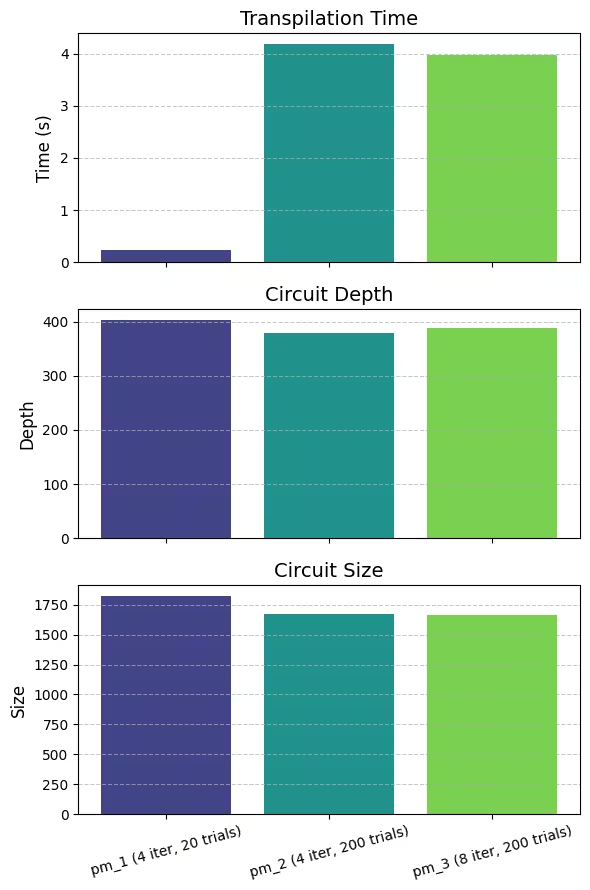
Step 3: Execute using Qiskit primitives
In this step, we use the Estimator primitive to calculate the expectation values for the ZZ operators, evaluating the entanglement and execution quality of the transpiled circuits. To align with typical user workflows, we submit the job for execution and apply error suppression using dynamical decoupling, a technique that mitigates decoherence by inserting gate sequences to preserve qubit states. Additionally, we specify a resilience level to counteract noise, with higher levels providing more accurate results at the cost of increased processing time. This approach allows us to assess the performance of each pass manager configuration under realistic execution conditions.
options = EstimatorOptions()
options.resilience_level = 1
options.dynamical_decoupling.enable = True
options.dynamical_decoupling.sequence_type = "XY4"
# Create an Estimator object
estimator = Estimator(backend, options=options)# Submit the circuit to Estimator
job_1 = estimator.run([(tqc_1, operators_list_1)])
job_1_id = job_1.job_id()
print(job_1_id)
job_2 = estimator.run([(tqc_2, operators_list_2)])
job_2_id = job_2.job_id()
print(job_2_id)
job_3 = estimator.run([(tqc_3, operators_list_3)])
job_3_id = job_3.job_id()
print(job_3_id)Output:
d0ltqe9p0ric73b0qgng
d0ltqeik4jhc73af6nvg
d0ltqesi1pis73cui9t0
# Run the jobs
result_1 = job_1.result()[0]
print("Job 1 done")
result_2 = job_2.result()[0]
print("Job 2 done")
result_3 = job_3.result()[0]
print("Job 3 done")Output:
Job 1 done
Job 2 done
Job 3 done
Step 4: Post-process and return result in desired classical format
Once the job completes, we analyze the results by plotting the expectation values for each qubit. In an ideal simulation, all values should be 1, reflecting perfect entanglement across the qubits. However, due to noise and hardware constraints, the expectation values typically decrease as i increases, revealing how entanglement degrades over distance.
In this step, we compare the results from each pass manager configuration to the ideal simulation. By examining the deviation of from 1 for each configuration, we can quantify how well each pass manager preserves entanglement and mitigates the effects of noise. This analysis allows us to directly assess the impact of the SABRE optimizations on execution fidelity, providing insights into which configuration achieves the best balance between optimization quality and execution performance.
The results will be visualized to highlight differences across pass managers, showcasing how improvements in layout and routing influence the final circuit execution on noisy quantum hardware.
data = list(range(1, len(operators) + 1)) # Distance between the Z operators
# Normalize and process expectation values for each result
values_1 = [v / result_1.data.evs[0] for v in result_1.data.evs]
values_2 = [v / result_2.data.evs[0] for v in result_2.data.evs]
values_3 = [v / result_3.data.evs[0] for v in result_3.data.evs]
plt.plot(
data,
values_1,
marker="o",
label="pm_1 (iters=4, swap_trials=20, layout_trials=20)",
)
plt.plot(
data,
values_2,
marker="s",
label="pm_2 (iters=4, swap_trials=200, layout_trials=200)",
)
plt.plot(
data,
values_3,
marker="^",
label="pm_3 (iters=8, swap_trials=200, layout_trials=200)",
)
plt.xlabel("Distance between qubits $i$")
plt.ylabel(r"$\langle Z_i Z_0 \rangle / \langle Z_1 Z_0 \rangle $")
plt.legend()
plt.show()Output:
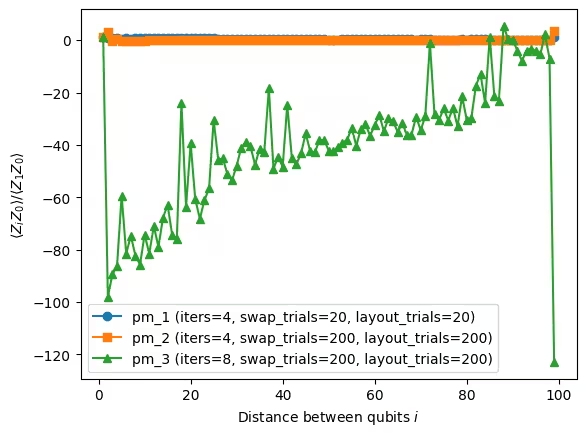
Analysis of Results
The plot shows how the normalized expectation values vary across qubits for the three pass managers. Ideally, all values should remain close to 1, reflecting strong entanglement. However, noise and hardware errors introduce deviations, influenced by circuit size and depth.
With the largest circuit size and depth, pm_1 exhibits significant variations in , particularly for qubits farther apart, indicating poorer preservation of entanglement due to accumulated noise. In comparison, pm_2 shows slightly improved results, with fewer deviations, reflecting its modest reductions in circuit size and depth (1–10% better than pm_1). These smaller improvements lead to slightly better fidelity but do not fully address the noise issues.
pm_3, with the most significant reductions in size and depth (11–20% better than pm_1), delivers the best results, with values much closer to 1 and fewer deviations. This highlights the critical role of minimizing circuit size and depth in reducing noise and error propagation, which significantly improves execution fidelity.
Part II. Configuring the heuristic in SABRE and using Serverless
In addition to adjusting trial numbers, SABRE allows customization of the routing heuristic used during transpilation. By default, SabreLayout employs the decay heuristic, which dynamically weights qubits based on their likelihood of being swapped. To use a different heuristic (such as the lookahead heuristic), you can create a custom SabreSwap pass and connect it to SabreLayout by running a PassManager with FullAncillaAllocation, EnlargeWithAncilla, and ApplyLayout. When using SabreSwap as a parameter for SabreLayout, only one layout trial is performed by default. To efficiently run multiple layout trials, we leverage the serverless runtime for parallelization. For more about serverless, see the Serverless documentation.
How to Change the Routing Heuristic
- Create a custom
SabreSwappass with the desired heuristic. - Use this custom
SabreSwapas the routing method for theSabreLayoutpass.
While it is possible to run multiple layout trials using a loop, serverless runtime is the better choice for large-scale and more vigorous experiments. Serverless allows for parallel execution of layout trials, significantly speeding up the process when optimizing larger circuits or conducting numerous experiments. This makes it especially valuable when working with resource-intensive tasks or when time efficiency is critical.
This section focuses solely on step 2 of optimization: minimizing circuit size and depth to achieve the best possible transpiled circuit. Building on the earlier results, we now explore how heuristic customization and serverless parallelization can further enhance optimization performance, making it suitable for large-scale quantum circuit transpilation.
Results without serverless runtime (1 layout trial):
swap_trials = 200
# Default PassManager with `SabreLayout` and `SabreSwap`, using heuristic "decay"
sr_default = SabreSwap(
coupling_map=cmap, heuristic="decay", trials=swap_trials, seed=seed
)
sl_default = SabreLayout(
coupling_map=cmap, routing_pass=sr_default, seed=seed
)
pm_default = generate_preset_pass_manager(
optimization_level=3, backend=backend, seed_transpiler=seed
)
pm_default.layout.replace(index=2, passes=sl_default)
pm_default.routing.replace(index=1, passes=sr_default)
t0 = time.time()
tqc_default = pm_default.run(qc)
t_default = time.time() - t0
size_default = tqc_default.size()
depth_default = tqc_default.depth(lambda x: x.operation.num_qubits == 2)
# Custom PassManager with `SabreLayout` and `SabreSwap`, using heuristic "lookahead"
sr_custom = SabreSwap(
coupling_map=cmap, heuristic="lookahead", trials=swap_trials, seed=seed
)
sl_custom = SabreLayout(coupling_map=cmap, routing_pass=sr_custom, seed=seed)
pm_custom = generate_preset_pass_manager(
optimization_level=3, backend=backend, seed_transpiler=seed
)
pm_custom.layout.replace(index=2, passes=sl_custom)
pm_custom.routing.replace(index=1, passes=sr_custom)
t0 = time.time()
tqc_custom = pm_custom.run(qc)
t_custom = time.time() - t0
size_custom = tqc_custom.size()
depth_custom = tqc_custom.depth(lambda x: x.operation.num_qubits == 2)
print(
f"Default (heuristic='decay') : Depth {depth_default}, Size {size_default}, Time {t_default}"
)
print(
f"Custom (heuristic='lookahead'): Depth {depth_custom}, Size {size_custom}, Time {t_custom}"
)Output:
Default (heuristic='decay') : Depth 364, Size 3193, Time 0.6306140422821045
Custom (heuristic='lookahead'): Depth 391, Size 3051, Time 0.3047943115234375
Here we see that the lookahead heuristic performs better than the decay heuristic in terms of circuit depth, size, and time. This improvements highlights how we can improve SABRE beyond just trials and iterations for your specific circuit and hardware constraints. Note that these results are based on a single layout trial. To achieve more accurate results, we recommend running multiple layout trials, which can be done efficiently using the serverless runtime.
Results with serverless runtime (multiple layout trials)
Qiskit Serverless requires setting up your workload’s .py files into a dedicated directory. The following code cell is a Python file in the source_files directory named transpile_remote.py. This file contains the function that runs the transpilation process.
import time
from qiskit.transpiler.preset_passmanagers import generate_preset_pass_manager
from qiskit.transpiler.passes import SabreLayout, SabreSwap
from qiskit.transpiler import CouplingMap
from qiskit_serverless import get_arguments, save_result, distribute_task, get
from qiskit_ibm_runtime import QiskitRuntimeService
service = QiskitRuntimeService()
@distribute_task(target={
"cpu": 1,
"mem": 1024 * 1024 * 1024
})
def transpile_remote(qc, optimization_level, backend, seed, swap_trials, heuristic):
"""Transpiles an abstract circuit into an ISA circuit for a given backend."""
pm = generate_preset_pass_manager(
optimization_level=optimization_level,
backend=backend,
seed_transpiler=seed
)
# Changing the `SabreLayout` and `SabreSwap` passes to use the custom configurations
cmap = CouplingMap(backend().configuration().coupling_map)
sr = SabreSwap(coupling_map=cmap, heuristic=heuristic, trials=swap_trials, seed=42)
sl = SabreLayout(coupling_map=cmap, routing_pass=sr, seed=seed)
pm.layout.replace(index=2, passes=sl)
pm.routing.replace(index=1, passes=sr)
# Measure the transpile time
start_time = time.time() # Start timer
tqc = pm.run(qc) # Transpile the circuit
end_time = time.time() # End timer
transpile_time = end_time - start_time # Calculate the elapsed time
return tqc, transpile_time # Return both the transpiled circuit and the transpile time
# Get program arguments
arguments = get_arguments()
circuit = arguments.get("circuit")
backend_name = arguments.get("backend_name")
optimization_level = arguments.get("optimization_level")
seed_list = arguments.get("seed_list")
swap_trials = arguments.get("swap_trials")
heuristic = arguments.get("heuristic")
# Get the backend
service = QiskitRuntimeService()
backend = service.backend(backend_name)
print(backend)
# Transpile the circuits
transpile_worker_references = [
transpile_remote(circuit, optimization_level, backend, seed, swap_trials, heuristic)
for seed in arguments.get("seed_list")
]
results_with_times = get(transpile_worker_references)
# Separate the transpiled circuits and their transpile times
transpiled_circuits = [result[0] for result in results_with_times]
transpile_times = [result[1] for result in results_with_times]
# Save both results and transpile times
save_result({"transpiled_circuits": transpiled_circuits, "transpile_times": transpile_times})The following cell uploads the transpile_remote.py file as a Qiskit Serverless program under the name transpile_remote_serverless.
serverless = QiskitServerless()
transpile_remote_demo = QiskitFunction(
title="transpile_remote_serverless",
entrypoint="transpile_remote.py",
working_dir="./source_files/",
)
serverless.upload(transpile_remote_demo)
transpile_remote_serverless = serverless.load("transpile_remote_serverless")Generate 20 different seeds to represent 20 different layout trials.
seed = 42
num_seeds = 200 # represents the different layout trials
seed_list = [seed + i for i in range(num_seeds)]Run the uploaded program and pass inputs for lookahead heuristic.
job_lookahead = transpile_remote_serverless.run(
circuit=qc,
backend_name="ibm_brisbane",
optimization_level=3,
seed_list=seed_list,
swap_trials=swap_trials,
heuristic="lookahead",
)job_lookahead.job_idOutput:
'f5475545-dd80-47fe-8a3d-3ef5d3f478fe'
job_lookahead.status()Output:
'QUEUED'
Receive the logs and results from the serverless runtime.
logs_lookahead = job_lookahead.logs()
print(logs_lookahead)Output:
No logs yet.
Once a program is DONE, you can use job.results() to fetch the result stored in save_result().
# Run the job with lookahead heuristic
start_time = time.time()
results_lookahead = job_lookahead.result()
end_time = time.time()
job_lookahead_time = end_time - start_timeNow perform the same for decay heuristic.
job_decay = transpile_remote_serverless.run(
circuit=qc,
backend_name="ibm_brisbane",
optimization_level=3,
seed_list=seed_list,
swap_trials=swap_trials,
heuristic="decay",
)job_decay.job_idOutput:
'084be271-68d0-49a3-a25d-3f5077e264ac'
logs_decay = job_decay.logs()
print(logs_decay)Output:
No logs yet.
# Run the job with the decay heuristic
start_time = time.time()
results_decay = job_decay.result()
end_time = time.time()
job_decay_time = end_time - start_time# Extract transpilation times
transpile_times_decay = results_decay["transpile_times"]
transpile_times_lookahead = results_lookahead["transpile_times"]
# Calculate total transpilation time for serial execution
total_transpile_time_decay = sum(transpile_times_decay)
total_transpile_time_lookahead = sum(transpile_times_lookahead)
# Print total transpilation time
print("=== Total Transpilation Time (Serial Execution) ===")
print(f"Decay Heuristic : {total_transpile_time_decay:.2f} seconds")
print(f"Lookahead Heuristic: {total_transpile_time_lookahead:.2f} seconds")
# Print serverless job time (parallel execution)
print("\n=== Serverless Job Time (Parallel Execution) ===")
print(f"Decay Heuristic : {job_decay_time:.2f} seconds")
print(f"Lookahead Heuristic: {job_lookahead_time:.2f} seconds")
# Calculate and print average runtime per transpilation
avg_transpile_time_decay = total_transpile_time_decay / num_seeds
avg_transpile_time_lookahead = total_transpile_time_lookahead / num_seeds
avg_job_time_decay = job_decay_time / num_seeds
avg_job_time_lookahead = job_lookahead_time / num_seeds
print("\n=== Average Time Per Transpilation ===")
print(f"Decay Heuristic (Serial) : {avg_transpile_time_decay:.2f} seconds")
print(f"Decay Heuristic (Serverless): {avg_job_time_decay:.2f} seconds")
print(
f"Lookahead Heuristic (Serial) : {avg_transpile_time_lookahead:.2f} seconds"
)
print(
f"Lookahead Heuristic (Serverless): {avg_job_time_lookahead:.2f} seconds"
)
# Calculate and print serverless improvement percentage
decay_improvement_percentage = (
(total_transpile_time_decay - job_decay_time) / total_transpile_time_decay
) * 100
lookahead_improvement_percentage = (
(total_transpile_time_lookahead - job_lookahead_time)
/ total_transpile_time_lookahead
) * 100
print("\n=== Serverless Improvement ===")
print(f"Decay Heuristic : {decay_improvement_percentage:.2f}%")
print(f"Lookahead Heuristic: {lookahead_improvement_percentage:.2f}%")Output:
=== Total Transpilation Time (Serial Execution) ===
Decay Heuristic : 462.49 seconds
Lookahead Heuristic: 439.38 seconds
=== Serverless Job Time (Parallel Execution) ===
Decay Heuristic : 172.37 seconds
Lookahead Heuristic: 159.30 seconds
=== Average Time Per Transpilation ===
Decay Heuristic (Serial) : 2.31 seconds
Decay Heuristic (Serverless): 0.86 seconds
Lookahead Heuristic (Serial) : 2.20 seconds
Lookahead Heuristic (Serverless): 0.80 seconds
=== Serverless Improvement ===
Decay Heuristic : 62.73%
Lookahead Heuristic: 63.74%
These results demonstrate the significant efficiency of serverless execution in quantum circuit transpilation. For 200 layout trials, serverless reduced the runtime by over 60% for both the decay and lookahead heuristics compared to serial execution. The total transpilation time for decay (443.29 s) and lookahead (400.65 s) highlights the computational effort required for serial execution, while the serverless job times (157.97 s and 158.12 s, respectively) showcase the dramatic runtime reduction achieved through parallelization. These findings emphasize that serverless execution can effectively scale to larger problems, offering substantial time savings and enabling broader exploration of optimization trials with minimal overhead.
Obtain the results from the serverless runtime and compare the results of the lookahead and decay heuristics. We will compare the sizes and depths.
# Extract sizes and depths
sizes_lookahead = [
circuit.size() for circuit in results_lookahead["transpiled_circuits"]
]
depths_lookahead = [
circuit.depth(lambda x: x.operation.num_qubits == 2)
for circuit in results_lookahead["transpiled_circuits"]
]
sizes_decay = [
circuit.size() for circuit in results_decay["transpiled_circuits"]
]
depths_decay = [
circuit.depth(lambda x: x.operation.num_qubits == 2)
for circuit in results_decay["transpiled_circuits"]
]
def create_scatterplot(x, y1, y2, xlabel, ylabel, title, labels, colors):
plt.figure(figsize=(8, 5))
plt.scatter(
x, y1, label=labels[0], color=colors[0], alpha=0.8, edgecolor="k"
)
plt.scatter(
x, y2, label=labels[1], color=colors[1], alpha=0.8, edgecolor="k"
)
plt.xlabel(xlabel, fontsize=12)
plt.ylabel(ylabel, fontsize=12)
plt.title(title, fontsize=14)
plt.legend(fontsize=10)
plt.grid(axis="y", linestyle="--", alpha=0.7)
plt.tight_layout()
plt.show()
create_scatterplot(
seed_list,
sizes_lookahead,
sizes_decay,
"Seed",
"Size",
"Circuit Size",
["lookahead", "Decay"],
["blue", "red"],
)
create_scatterplot(
seed_list,
depths_lookahead,
depths_decay,
"Seed",
"Depth",
"Circuit Depth",
["lookahead", "Decay"],
["blue", "red"],
)Output:
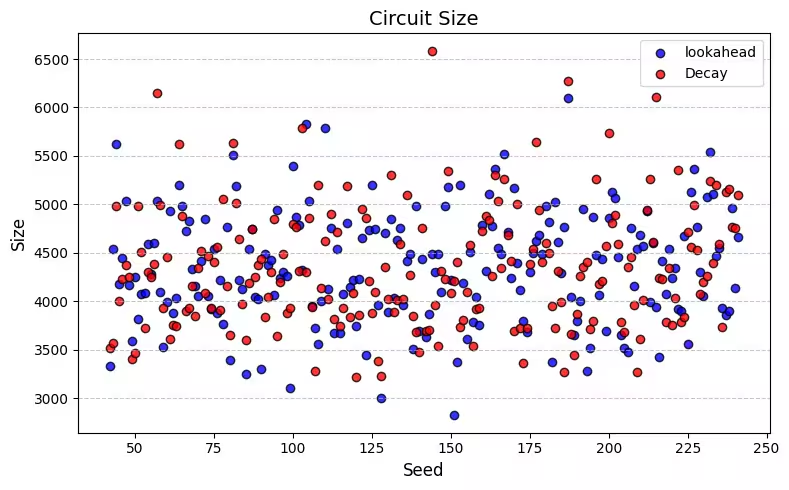
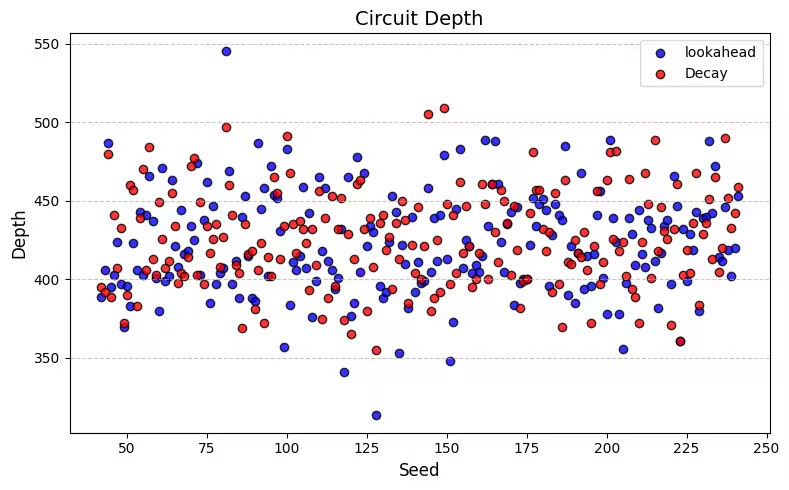
Each point in the scatter plots above represents a layout trial, with the x-axis indicating the circuit depth and the y-axis indicating the circuit size. The results reveal that the lookahead heuristic generally outperforms the decay heuristic in minimizing circuit depth and circuit size. In practical applications, the goal is to identify the optimal layout trial for your chosen heuristic, whether prioritizing depth or size. This can be achieved by selecting the trial with the lowest value for the desired metric. Importantly, increasing the number of layout trials improves the chances of achieving a better result in terms of size or depth, but it comes at the cost of higher computational overhead.
min_depth_lookahead = min(depths_lookahead)
min_depth_decay = min(depths_decay)
min_size_lookahead = min(sizes_lookahead)
min_size_decay = min(sizes_decay)
print(
"Lookahead: Min Depth",
min_depth_lookahead,
"Min Size",
min_size_lookahead,
)
print("Decay: Min Depth", min_depth_decay, "Min Size", min_size_decay)Output:
Lookahead: Min Depth 314 Min Size 2829
Decay: Min Depth 355 Min Size 3221
In our initial comparison of heuristics using a single layout trial, the lookahead heuristic yielded the best result with a depth of 389 and size of 3384. By leveraging multiple trials through QiskitServerless, we explored various layout options for each heuristic, enabling a more comprehensive evaluation. Interestingly, the decay heuristic outperformed the lookahead heuristic in some cases, achieving a minimum depth of 355 and a minimum size of 3221 across the trials. However, the lookahead heuristic ultimately delivered the best overall results, with a minimum depth of 314 and a minimum size of 2829. This represents a significant improvement over its single-trial performance, highlighting the advantages of using serverless runtime for multi-trial optimization.
These findings underscore the importance of experimenting with different heuristics and tailoring them to specific scenarios. By systematically comparing performance across multiple trials, we can identify the heuristic that delivers the optimal trade-off between depth and size for a given problem. This approach ensures more robust and efficient quantum circuit transpilation.
Conclusion
In this tutorial, we explored how to optimize large circuits using SABRE in Qiskit. We demonstrated how to configure the SabreLayout pass with different parameters to balance circuit quality and transpilation runtime. We also showed how to customize the routing heuristic in SABRE and use the QiskitServerlessruntime to parallelize layout trials efficiently for when SabreSwap is involved. By adjusting these parameters and heuristics, you can optimize the layout and routing of large circuits, ensuring they are executed efficiently on quantum hardware.
Tutorial survey
Please take one minute to provide feedback on this tutorial. Your insights will help us improve our content offerings and user experience.